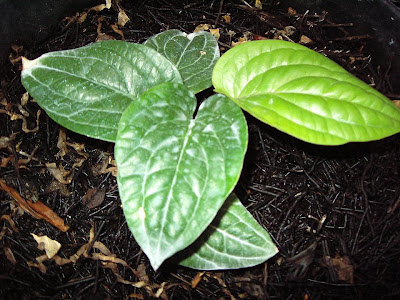 |
| Piper betle |
Plant | Piper betle | Family : Piperaceae, Genus : Piper,Species : P. betle a height of 2 to 4 meters. Upper leaves are usually oblong-elliptic, oblong-ovate or ovate, 6 to 17.5 cm long, 3.5 to 10 cm wide, mostly 7-plinerved, smooth on both surfaces. Male spikes are subpendulous, slender, 7 to 13.5 cm long, and 2 to 3.5 mm in diameter.
Rachis is hairy. Stamens are two, stalked, 0.75 to 1 mm long; and the anthers reniform. Female spikes, when mature, are red, fleshy, oblong to elongated oblong, 3 to 8 cm long, and 0.5 to 1 cm thick. Rachis is hairy, and the bracts stalkless, peltate, with a smooth disk, transversely oblong to suborbicular, and about 1 cm wide. Fruit is coalescing, fully embeded in the pulp and concrescent with the rachis. Seeds are smooth, oblong to globose-obovoid, 2.25 to 2.6 mm long, and about 2 mm in diameter. Stigmas are 4 to 6, and rarely, 3. |
| Piper betle |
Commons names The betel leaf is known as Paan in Assamese/Urdu/Hindi/Odia/Bengali, and Tambula and Nagavalli in Sanskrit. Some of the names in the regions in which it is consumed are: Vetrilai (Tamil),Tamalapaku (Telugu), Vidyache pan (Marathi), veeleyada yele (Kannada), Vettila (Malayalam), Plū (Mon), Malus (Tetum), Maluu (Khmer), Maak (Thai: หมากสง), Bulath (Sinhalese), Malu (Tokodede), Bileiy (Divehi), bulung samat (Kapampangan), daun sirih (Malay), Papulu (Chamorro), Ikmo (Philippines), Pu (ພູ) in Lao, and Trầu (Vietnamese).
 |
| Piper betle |
In a study conducted in Papua New Guinea, scientists found oral squamous cell cancer as the most common malignant tumour in Papua New Guinea. They report that the oral cancer is concentrated at the corner of the mouth and cheek, and corresponds precisely with chewing site of betel leaf with lime in 77% of 169 cases. Powdered slaked lime applied to the chewed areca nut placed inside a betel leaf causes the mean pH to rise to 10, at which reactive oxygen species are generated from betel quid ingredients in vitro. Reactive oxygen species, together with sustained lime-induced cell proliferation, the scientists claim suggest a possible mechanism of carcinogenesis for this tumor.
In a study conducted in Taiwan, scientists found[12] betel chewing increases the risk of cardiovascular disease and mortality. In this study, they investigated the association between betel nut chewing and general obesity (BMI 25 kg/m2) and central obesity. Using multiple linear regression analyses, after adjusting for potential confounders, they claim betel consumption was statistically significantly associated with obesity. The reason for this link between obesity and betel leaf chewing, the scientists admit is unclear.
 |
| Piper betle |
In Bangladesh, farmers called barui prepare a garden called a barouj in which to grow betel. The barouj is fenced with bamboo sticks and coconut leaves. The soil is plowed into furrows of 10 to 15 metres' length, 75 centimetres in width and 75 centimetres' depth. Oil cakes, manure, and leaves are thoroughly incorporated with the topsoil of the furrows and wood ash. The creeper cuttings are planted after proper dressing in the months of May and June, at the beginning of the monsoon season. The plants are neatly arranged in parallel rows about two feet apart, and the saplings are twined around upright sticks of split bamboo and reeds.
Proper shade and irrigation are essential for the successful cultivation of this crop. The plants are regularly watered in the hot months. The leaves of the plant become ready for plucking after one year of growth and the production of the barouj lasts for several years from the date of planting. Betel needs constantly moist soil, but there should not be excessive moisture. Irrigation is frequent and light, and standing water should not remain for more than half an hour.
Proper shade and irrigation are essential for the successful cultivation of this crop. The plants are regularly watered in the hot months. The leaves of the plant become ready for plucking after one year of growth and the production of the barouj lasts for several years from the date of planting. Betel needs constantly moist soil, but there should not be excessive moisture. Irrigation is frequent and light, and standing water should not remain for more than half an hour.
No comments:
Post a Comment